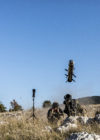Successful MMP firing with target designation made by a Novadem drone

MBDA has carried out the first demonstration of the operational capabilities of LYNKEUS Dismounted, comprising the MMP system in “infantry” configuration and a Novadem NX70 drone linked via radio to its weapon terminal.
Carried out with the support of the French Army and of the Direction Générale de l’Armement (DGA – French Procurement Agency) at the Canjuers military camp in the south of France, this firing was representative of a ‘beyond Line of sight’ (BLOS) engagement.
During this demonstration, the drone enabled the detection and identification of a tank located outside the MMP operator’s field of vision. The transfer of the coordinates for the target to the MMP firing station illustrated the possibility of engaging a target not directly seen by the operator. The missile was “locked-on” to the target during its flight by the MMP operator after detecting the tank via the video stream from the MMP seeker, which was continuously transmitted to the firing station via fibre optics. The demonstration successfully concluded with a direct hit on the target.
This demonstration confirms the capabilities offered by LYNKEUS for the quality and control of the information chain going from the drone to the firing station. It also proves the precision of the extraction of the coordinates for the target.
Philippe Gouyon, Military Advisor at MBDA, said: “This firing also concludes a year-long tactical evaluation conducted with the Army and Novadem exploring all the capabilities of the system and thus, allows MBDA to propose an MMP / drone combination that meets the needs of remote observation and target designation of contact units.
These experiments notably included real-time engagement simulations in virtual reality but also combining, in the field, real equipment (drones, weapon terminal) and MMP simulators implemented by Land Forces units. We are very satisfied with the results of this work, which made it possible to understand the forces’ needs to finalize the system carrying the BLOS capability for dismounted combat.”
The collaborative engagement capacity allowing firing ‘beyond line of sight’ is a breakthrough operational concept, supported at European level by the participants in the PESCO BLOS project.

MBDA a procédé à la première démonstration des capacités opérationnelles de LYNKEUS Dismounted, comprenant le système MMP en configuration « fantassin », doté de son terminal arme en liaison radio avec le drone Novadem NX70.
Réalisé avec le soutien de l’armée de Terre et de la Direction générale de l’armement (DGA), sur le camp militaire de Canjuers dans le sud de la France, ce tir était représentatif d’un engagement ‘au-delà de la vue directe’.
Lors de la démonstration, le drone a permis la détection et l’identification d’un char situé hors du champ de vision de l’opérateur. Les coordonnées de la cible ont ensuite été transférées au poste de tir MMP, selon une séquence illustrant la possibilité d’engager une cible qui n’a jamais été en vue directe du tireur. Le char a été « accroché » par le missile pendant son vol suite à l’action du tireur qui l’a détecté dans le flux vidéo de l’autodirecteur MMP transmis, de manière continue, au poste de tir par fibre optique. Cette démonstration s’est conclue par un impact direct sur la cible.
Cette démonstration vient confirmer les capacités offertes par LYNKEUS de maitrise et de qualité de la chaine d’informations allant du drone au poste de tir et prouve également la précision de l’extraction des coordonnées de la cible.
Pour Philippe Gouyon, conseiller militaire chez MBDA « Ce tir vient aussi conclure une évaluation tactique (EVTA) conduite depuis environ un an avec l’armée de Terre et Novadem afin d’explorer toutes les capacités du système et, permet ainsi à MBDA de proposer un couplage MMP/drone répondant aux besoins d’observation déportée et de désignation de cibles des unités de contact. »
Il poursuit « Ces expérimentations comprenaient notamment des simulations d’engagement temps-réel en réalité virtuelle mais aussi combinant, sur le terrain, équipements réels (drones, terminal arme) et simulateurs MMP mis en œuvre par des unités des Forces terrestres. Nous sommes très satisfaits des résultats de ces travaux qui ont permis de bien comprendre le besoin des forces afin de finaliser le système porteur de la capacité TAVD pour le combat débarqué. »
La capacité d’engagement collaboratif permettant des tirs ‘au-delà de la vue directe’, est un concept opérationnel de rupture, porté au niveau européen par les participants au projet PESCO BLOS.


